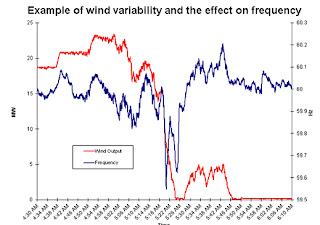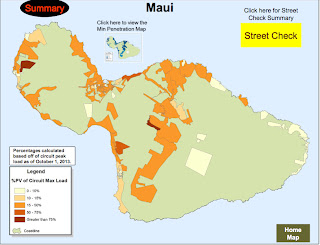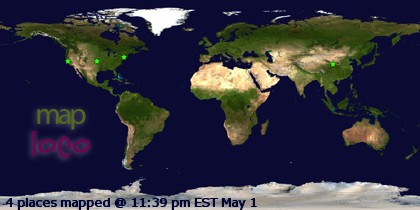My personal reluctance to fully embrace alternative energy, by the way, comes not from a love of oil or gas, but an understanding from an engineering perspective of the limitations of every source of energy we use, and you can see those limitations live on Maui. Take wind power, for instance.
It seems pretty benign, having big windmills up in the sky over land or sea. But windmills do a major serious number on birds -- especially raptors -- and bats. Maui's 51 MW Kaheawa Wind wind farm's environmental impact assessment makes it clear that the wind farm will kill endangered nene (goose), bats and other birds. They are permitted to kill only specific numbers of birds a year or risk being shut down. Wind farms have a track record of killing off or creating "no-fly" zoned for raptors that control rodent populations, with corresponding adverse consequences on agricultural yields.
Windmills have downstream effects on weather patterns. Large wind farms in California have resulted in decreased rainfall in the lee of the farms.
Not everyone loves wind farms. Take these guys, for instance, trying to block a wind farm near Ottawa. I remember reading complaints about the Kaheawa project in the Maui News before the project was built.
But the biggest issues from an engineering perspective is that windmills only work when the wind blows, and far more importantly, change their power output with every minor change in wind speed or direction. See just how variable it can be here, or just look at the picture below (take a careful look at the X-axis scale).
 |
| It dropped from 22 MW to 0 MW in 20 minutes |
Solar (referred to on Maui as "PV, or photovoltaic) is even worse from a variability perspective. Solar only provides power on a curve that starts at sunrise, peaks in the middle of the day, and falls off to sunset, changing whenever a cloud comes by. That demand link I gave above or you can see here shows the solar insolation profile. Again, there's big differences between the potential PV supply and the demand curve.
Still, tax incentives have encouraged people to put PV panels on their roofs -- Hawai'i is a national leader in solar power -- and Maui is full of PVs. There is 4,300 MW of installed PV capacity on Maui. See how fast PV has grown here. But how full is the system? Again, Maui Electric shows you. See here for access to full sized pictures for the whole state; a small version of the two critical maps for Maui are below.
Map 1: Installed PV as a percentage of minimum daily electrical load:
The darker the blue, the more PV there is. Note that there are places -- lots of places -- where PV generation capacity is in excess of minimum electrical use. These neighbourhoods are net "exporters" of electricity to other neighbourhoods (when the sun is shining). That is to say, on a daily average basis, they generate more electricity than they consume -- but of course, at night, they are importers of electricity fueled by something other than solar (in Maui's case, wind, if it's blowing, or diesel).
Map 2: Installed PV as a percentage of total circuit load:
The darker the orange, the more PV exists as a percentage of the total capacity of the wires to take that generated electricity to somewhere else. Note that there are two places where there is so much PV energy generation capacity that the grid can't take it away.
Maui has said that if the PV represents less than 15% of the total circuit's carrying capacity, you can freely put a PV system on your roof and make all the energy you want. Not much of the island is left that can do that (primarily Wailea, Makena & Kapalua). Any more than 15% and you have to go through a process for approval. Why? Because the high variability PV makes for incredibly difficult electricity balancing. Electrical customers don't want brownouts whenever it's cloudy or the wind slows down.
So Maui's learning: if you don't have much wind or solar power as a percentage of electrical demand, adding it is easy and makes sense. But over 15% and there are problems. See how bad it's getting on Oahu here. Don't believe all this? Have a read of this Scientific American article on the topic.
We like to think electricity is easy and clean and nice. But there are LOTS of engineering problems with electricity (line losses, inefficient conversion from potential to kinetic energy, etc), but the biggest is you can't store it. Push an electron into a wire and an electron has to come out somewhere. Battery technology gets better all the time, but big deal, it's WAY too expensive and results in massive energy loss through heat. In 2012, we visited the Taum Sauk pumped storage reservoir, where excess electricity generated is used to pump water up to the top of a mountain, to be let out during peak demand. In an engineering sense, extremely inefficient and massively wasteful of energy, but you could do it here (so long as someone will let you build a lake on the top of a mountain). Maui Electric looks into pumped storage and other energy storage options here and here. Oil's easy to store. It comes stored.
(Aside: As an engineer, I think they should consider using excess electrical energy to electrolyse seawater, split it into oxygen & hydrogen, recover the hydrogen, then store that and burn it instead of oil. Electrolysis takes a LOT of energy, a by-product is bad chlorine gas, hydrogen is too volatile a fuel to use in anything other than an industrial application, and when you burn it all you make is water on an island that needs water. Perfect where you have a lot of seawater, a lot of wind power, a need to purify drinking water, and the only generating station sits on the shoreline -- but that's just me).
An article in today's Maui News announced that Hawai'i Electric just received a million dollar grant to study ways to improve forecasting associated with PV unpredictability (I'd link it, but the Maui News is no longer free on line). The issue of electrical grid balancing with PV or wind is so significant here that Maui Electric and partners are running some experiments. They've teamed with a Japanese company in my neighbourhood to sign up houses with PV system, and 200 Nissan LEAF electric car owners, to try to put in some high tech stuff to balance out the grid. It's gonna cost millions just for one little neighbourhood.
It's a wonderful feeling to tell people that you're "net negative" in terms of electricity -- that you make more than you use -- but it's misleading to suggest that means you've weaned yourself off oil and gas. Until viable storage systems exist, at anything other than full direct sun, or when the winds aren't blowing steadily, you're still reliant on the oil and gas you claim you can do without. Someone I know just posted this:
If you do not like pipe lines and the dirty tar sands mess, I am thinking that there is a great lesson to be learned from the T'Sou-ke First Nation on the south tip of Vancouver Island. The 40 home Reserve is now energy independent by making use of solar panel arrays. Chief Gordon Plances and the entire Souk community should be commended. They are not only energy indepependent but are also producing the hot water needed for residents. The 75 kilowats produced on the Reserve are sufficient to export electricity to the British Columbia power grid.Nonsense. That 40 home reserve is not "energy independent". Between 7 PM and 6 AM, and any time it's cloudy or calm, they are wholly dependant on hydro power (you know, that stuff that makes dams and floods valleys that people fight against) and oil and gas. And they will be basically for a long time to come. The "great lesson to be learned" is that oil and gas won't go away any time soon. Commended? Sure; every little bit is going to help in the issue of the long term supply of viable energy. But they shouldn't be carried off on anyone's shoulders for being able to rip up pipelines and stop oil and gas production. Far from it.
Wind and solar are cool technologies, but the reality is, they will never fully replace oil and gas without massive step changes in energy storage technology -- and Hawaii and Maui might not even get to their 2030 target of 30% on average. I say that not as an oil and gas weenie but as an engineer who understands the limitations of the technologies. Anyone who doesn't believe me simply needs to look at the live, real-time, large scale (not 40 home) experiment going on in Maui or Hawai'i -- a place where the wind blows, the sun shines, the ground is hot, the waves move -- and oil and gas will make up the lion's share of the energy supply for a long time to come.
October 2015 Update: Hawai'i as a state just broke the 15% penetration and changed the rules. In order to manage rooftop PV, you now have to provide battery storage, or you can't feed the power back to the grid. Remember, it's PV feeding into the grid that screws it up. See the news info here. They call it "the death of solar". Oahu hit the cap first, but Maui's close.
February 2017 Update: Maui County's plan to go to 100% renewable will cost $10 Billion.




No comments:
Post a Comment